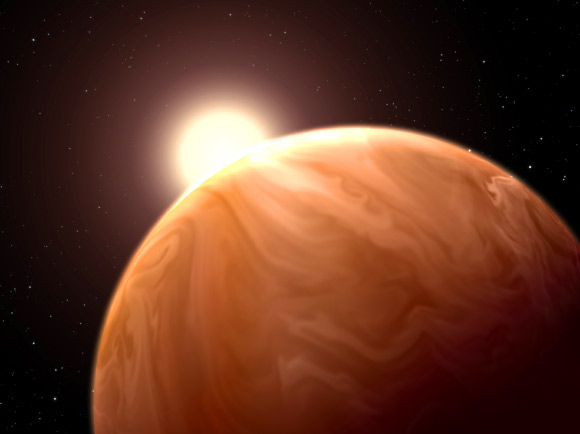A team of scientists from the University of Washington and the University of Toronto is the first to simulate 3D exotic clouds in the atmosphere of an exoplanet.

An artist’s impression of GJ 1214b. Image credit: NASA / ESA / G. Bacon, STScI / L. Kreidberg and J. Bean, University of Chicago / H. Knutson, California Institute of Technology.
The object in question is GJ 1214b, a so-called mini-Neptune exoplanet that was discovered six years ago by astronomers at the Harvard-Smithsonian Center for Astrophysics.
Also known as Gliese 1214b, this alien world is about 2.7 times Earth’s diameter and weighs almost seven times as much. It is located 52 light-years away in the constellation Ophiuchus.
The planet orbits a red dwarf star, GJ 1214, every 38 hours at a distance of 1.3 million miles.
According to previous studies, the planet has a water-rich or a hydrogen-dominated atmosphere with extensive clouds.
“There could either be high clouds in the atmosphere or an organic haze – like we see on Titan. Its atmospheric temperature exceeds the boiling point of water,” said team member Dr Benjamin Charnay, of the University of Washington.
“As a result, if GJ 1214b sported clouds, they would probably be some form of salt. But such clouds should form deep in the atmosphere, much lower than the altitude where they are observed.”
Dr Charnay and co-authors modeled how the clouds could form in the lower atmosphere of GJ 1214b and then rise into the upper atmosphere with sufficient circulation. To accomplish this, the team used a climate model called 3D General Circulation Model.
It shows how GJ 1214b could create, sustain and lift salt clouds into the upper atmosphere.
The model also makes specific predictions about the effect these clouds will have on the planet’s climate and the types of information that future telescopes, like the James Webb Space Telescope, will be able to gather.
The results are reported in a paper published online by the Astrophysical Journal Letters (arXiv.org preprint) on October 22, 2015.
_____
Benjamin Charnay et al. 2015. 3D modeling of GJ1214b’s atmosphere: formation of inhomogeneous high clouds and observational implications. ApJ 813, L1; doi: 10.1088/2041-8205/813/1/L1







